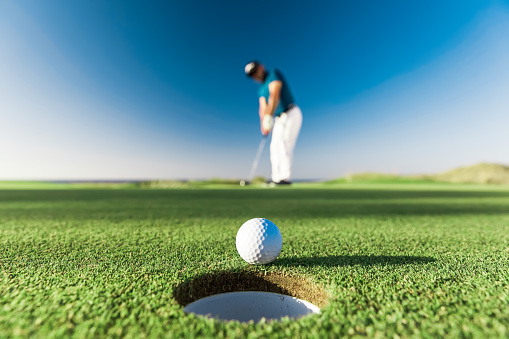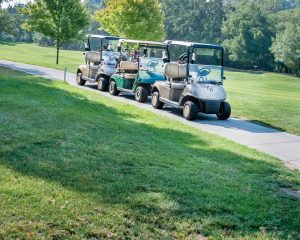When you’re starting out in golf, it’s important to be familiar with the sport’s terminology. There are many terms and phrases that are used on a regular basis. If you’re new to the game, it can be helpful to learn some of these terms so that you can follow along with the conversation. Here are some of the most common golf terminology for beginners:
Golf Terminology for Beginners

Tee
The tee is a small platform that golfers use to hit the ball from. The tee is located at the beginning of the golf course, and it’s where players hit the ball to start their round.
Fairway
The fairway is the area of the golf course that is between the tee and the green. The fairway is usually well-manicured and easy to walk on.
Green
The green is the area of the golf course where the players are trying to hit their ball in order to sink it into the hole. The green is often surrounded by bunkers and other hazards.
Hole
The hole is the target that golfers are trying to hit their ball into. The hole is usually a circular area that is about 4.5 inches in diameter.
Bunker
A bunker is a golf hazard that is found on the golf course. Bunkers are typically large and filled with sand.
Rough
The rough is the area of the golf course that is located between the fairway and the green. The rough is usually covered in grass, and it can be difficult to hit the ball from this area.
Caddie
A caddie is a person who helps golfers with their golf game. Caddies can provide players with information about the golf course, as well as tips on how to play the game.
Club
A golf club is a tool that golfers use to hit the ball. There are many different types of golf clubs, and each one is designed for a specific purpose.
Driver
The driver is a type of golf club that is used to hit the ball off of the tee. Drivers are typically the longest golf clubs in a player’s bag, and they are used to hitting the ball a long distance.
Iron
Iron golf clubs are used to hit the ball from the fairway and the rough. Irons are typically shorter than drivers, and they are designed to hit the ball accurately.
Wedges
Wedges are golf clubs that are used to hit the ball close to the hole. Wedges are designed to be used in tight situations, and they can help players get out of difficult situations.
Putter
The putter is a golf club that is used to hit the ball into the hole. Putters are typically used on the green, and they are designed to help players make accurate shots.
Handicap
If you did well in the past, this number tells you how many strokes to add or subtract from your score at the end of the round. The goal of a handicap is to level the playing field for golfers of different skills.
Clubhouse
A golf course that has the facilities inside of it. Usually, locker rooms, restaurants, a pro shop, bars, and a manager’s office are inside the bunker, but this is not always the case. This is where you can make complaints about how the bunker is being taken care of. Afterward, it’s best to stay in the bar and drink with your group.
Compression
The standard way to measure how hard a golf ball is. It is easier to compress at a lower level than it is at a higher level. High handicappers and slow swingers are now getting golf balls with lower compression (softer) ratings, which makes them easier to hit and easier to putt.
Divot
Some grass is torn from the ground during golf shots. Some golf courses don’t want you to replace your divots, but the majority of them will come up with a way to keep us, golfers, from ruining their perfectly manicured greens. You might have to move the divot or fill in the hole with sand depending on the type of grass you have in your yard.
Forgiveness
When a golf club makes better and longer shots on mishits, it makes it easier to play with. Super Game Improvement clubs make it a lot easier to hit the ball. There are a lot of clubs that can be forgiving. Drivers, fairway woods, irons, and wedges are just some of the examples. Beginners should pay the most attention to this when they buy golf clubs.
Gimme
Your friends think you’ll make short putts. They will “give” you the putt, which you can then pick up and count as one stroke when you play. They aren’t allowed in strokeplay competitions, but they are allowed in matchplay and games with your friends and family, as well. In the beginning, you can expect your games to be shorter than those of more experienced players, who might get games up to three feet long.
Grain
When the grass grows in a certain direction, it can change the putting surface and how much break there is in putts. The grass on the greens changes depending on the weather. There are two types of greens: coarser grass is used in hot, humid, and rougher climates, while finer grass is used in temperate and cooler climates. Bermuda grass is a type of grass that is very rough.
Match play
People or teams play against each other on each hole of the golf course. If you get a 4 and he gets a 5, you win the hole. You play against someone else. The goal is to win most of the tournament’s 18 holes. Finally, there’s no way to keep track of how many strokes you make. To figure out who won, only strokes on each hole are taken into account.
Pitch mark
Marks on the greens show where the ball is. It is always better to use a tool made for this job to fix these small plug marks.
Play through
In golf, you should ‘play through’ when a group that is moving faster than you is in front of you. You should stop your game and let them play their shots past you before going to the next hole.
Rangefinder
It is a laser device that is used to measure the distances between and among things on the course. Usually, this is used to figure out how far it is to hazards or the pin. Many low-cost rangefinders are available for people who want to quickly improve their skills.
Final thoughts
Now that you know some of the most common golf terminologies, you’ll be able to follow along with the game more easily. Be sure to familiarize yourself with these terms, and practice using them on the golf course. You’ll be a pro in no time!






